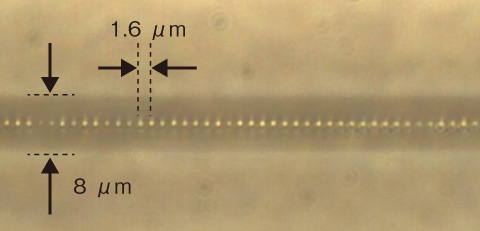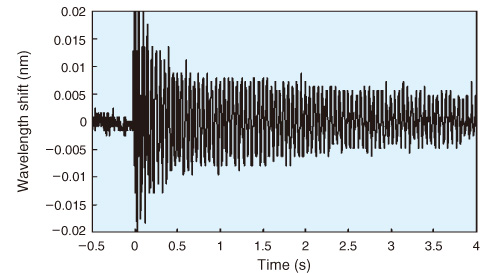
Fig.5-15 Fiber Bragg grating

Fig.5-16 Vibration monitoring by FBG sensor
It is necessary to monitor the structural health of the coolant piping systems in operational nuclear power plants to reduce the risk of cracking accidents due to thermal expansion stress or intense seismic force. However, commercially available sensors cannot be used at the operational temperature of fast breeder reactors.
We successfully developed fiber Bragg grating (FBG) sensors by femtosecond laser processing that can realize index modulation along an optical fiber core. The reflectivity was enhanced at the wavelength that corresponded to the periodic spacing of the modulation. If the sensors are installed along pipe lines, the wavelength shift can tell us the deformation or oscillation caused by an intense external force. The high sensitivity ensures structural monitoring for not only extraordinary events but also daily operation.
When femtosecond laser pulses are focused inside silicate glass, the locally heated zone expands far beyond the melting point. After quenching, the central heated zone exhibits low density, whereas the outer zone exhibits high density. Thus, femtosecond laser processing, called the optical knife technique, can generate index modulation in glass material that can be maintained permanently below the melting temperature. The wavelength of ultraviolet lasers cannot be used because of the absorption in the clad glass around the surface. The pulse duration of nanosecond lasers is too long to produce thermal cracks in the fiber core. Only an infrared femtosecond laser can process the periodic dot that can act as the grating (Fig.5-15).
In addition, the most important technology for the installation of FBG sensors on the piping systems in nuclear power plants is reinforcement with heatproof fabric. Here we selected SiC fiber, which is strong enough to protect the optical fiber from degradation caused by heat and radiation. The combined optical fiber and SiC fabric successfully strengthen the sensor for handling. We found the appropriate temperature conditions for each heatproof epoxy and ceramic adhesive. The strengthened FBG sensor exhibited superior linearity from room temperature to 600 °C. Further, it demonstrated monitoring of the seismic vibration of a piping system below 400 °C (Fig.5-16).
Japan has many nuclear power plants and petrochemical complexes that were constructed during periods of strong economic growth. These facilities are now facing aging problems. We experienced a massive earthquake and huge tsunami on March 11, 2011. Now we should reconsider the possibility that more catastrophic massive earthquakes might hit Japan again in the near future. To maintain the piping systems in these aging facilities by sensing technology is one of the minimum obligations of the facilities managers.